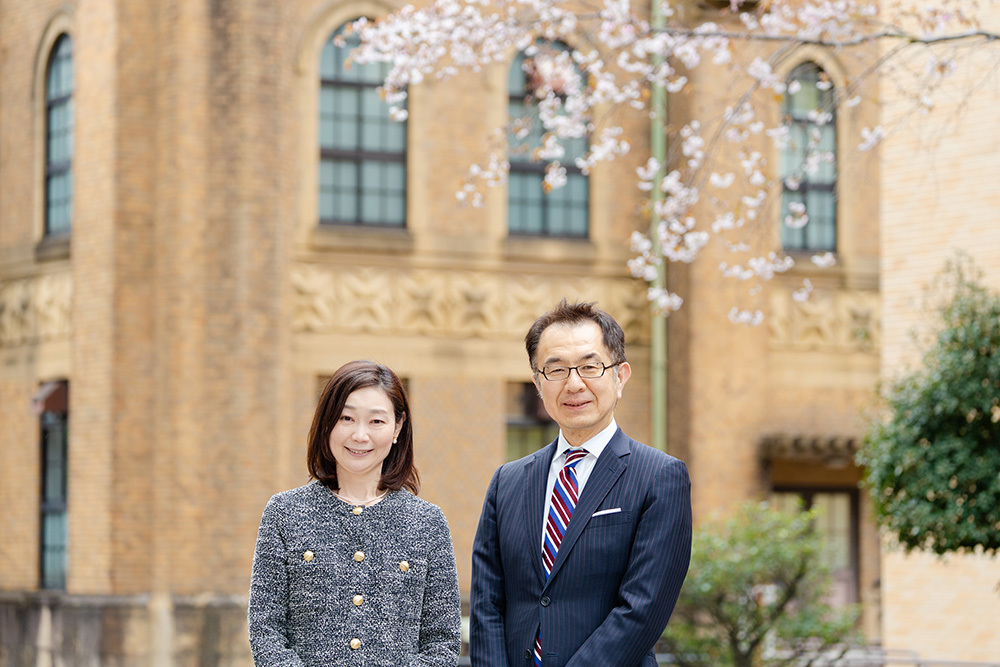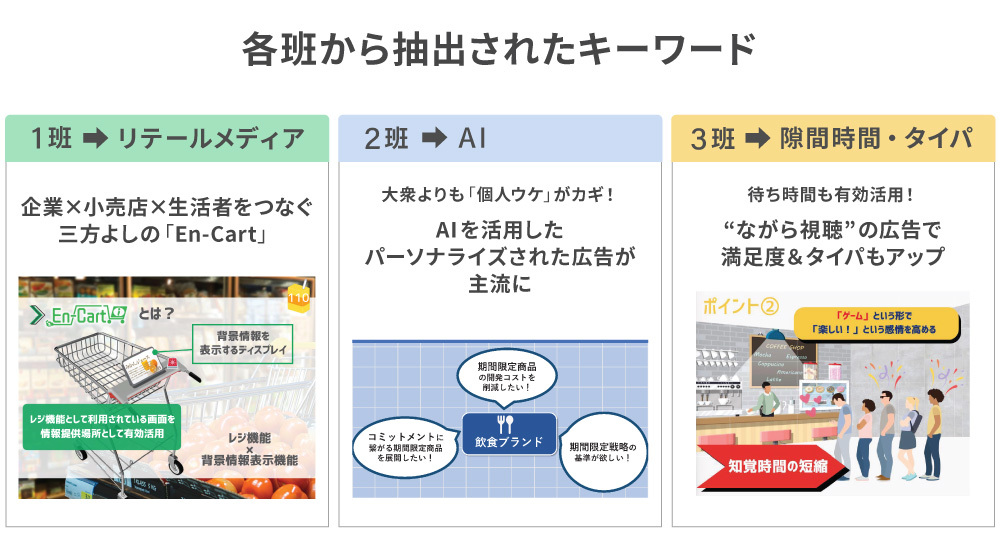
(From left) Dentsu Inc. Rie Sakaki, Keio University Faculty of Business and Commerce Professor Akira Shimizu
Could we leverage the real media usage patterns and insights of university students for our research activities on the future of media and advertising? This question sparked the initiative. With the cooperation of Professor Akira Shimizu's seminar at Keio University's Faculty of Business and Commerce, Dentsu Inc. Media Innovation Lab conducted workshops in July and December 2024.Students proposed various ideas centered on the theme: "What will media, communication, and effective advertising/promotion look like in 10 years?"
Read the first article here:
In this second article, we will explore the future signs for media and advertising by examining the ideas and keywords presented in the workshop alongside Professor Shimizu. The interviewer is Rie Sakaki from Dentsu Inc. Media Innovation Lab.

Retail media is gaining attention. With online purchases increasing, what is the role of physical stores?
Sakakibara:Three groups presented various ideas at the workshop. Group 1 proposed strategies leveraging retail media, which has gained significant attention in recent years. While customer experiences in stores are becoming richer, online purchasing and online advertising continue to expand. How will consumers' purchasing experiences change going forward?
Shimizu: With smartphones now ubiquitous and virtually anything purchasable online, discussions and research on the "role of physical stores" are underway globally. The key lies in customer experience. How much experiential value can be delivered through that experience becomes crucial. This means going beyond merely providing products or services; it requires considering how to offer positive emotions like enjoyment, delight, and fun.
Physical stores play a vital role as contact points for delivering this experiential value.

Sakakibara: So, are physical stores shifting from being places that provide products and services to becoming places for customer experience?
Shimizu: I believe this trend is occurring across the entire retail industry. Regarding retail media, if we can leverage purchase data to deliver information optimized for the individual, the timing, and the situation—through channels like shopping carts (as mentioned in Group 1's presentation), store-specific apps, and digital signage—the customer experience will become richer.
Furthermore, consumer behavior itself, particularly among younger generations, has significantly changed due to the proliferation of social media. When one retailer experimentally allowed in-store photography and social media posting, photos and comments taken by visitors were continuously uploaded to social media. People who saw these then clicked "like," demonstrating the potential for information diffusion and word-of-mouth effects. In other words, physical stores become the starting point for information dissemination and take on a role in promotion.
Another interesting experiment comes from research I'm co-leading. We had participants wear eye-tracking cameras to analyze their shopping behavior and word-of-mouth tendencies in-store. The results showed that while people were more likely to want to share word-of-mouth when approaching a shelf that caught their interest or when intrigued, once they were actually selecting products in front of a shelf, the desire to share significantly decreased.
From a promotional perspective, this shows that simply displaying products isn't enough. The crucial point in designing the customer experience is whether you can spark curiosity ("What's this?") or evoke excitement. Don Quijote, the discount store, is a clear example. While the store seems chaotic and cluttered at first glance, making shopping appear difficult, it creates that treasure-hunt excitement, right?
The key to driving consumer needs is "moderate incongruity." Can AI achieve this?
Sakakibara: Team 2 presented that personalized advertising using AI will become mainstream. AI might usher in an era where ads and communication are customized to capture not just the moment, but also the individual's occasion (situation) and mode (mood). How do you think advertising and media will change with AI's evolution?
Shimizu: AI excels at aggregating, analyzing, and synthesizing all manner of information from the world. To put it simply, imagine I have suits from Companies A and B, both known for their fabric quality, and I prefer shoes from Brand C. AI might suggest spring or winter suits from A and B between seasons, or analyze my purchase history to recommend Brand C's new shoes at the optimal time.
However, suppose there are many other manufacturers that specialize in fabric, and deep down, I actually wanted to try suits from a different brand. As long as AI bases its analysis and suggestions solely on purchase history, it's difficult for it to discern my true inner desires and make new proposals. Considering this, the mainstream adoption of personalized advertising might be a bit further off in the future.
However, consumer behavior theory includes the concept of "moderate misalignment." This refers to feeling that something is "close to what I wanted, but somehow different." Interestingly, this slight mismatch can sometimes trigger a shift in the consumer's thinking: "Oh, there's something like this too. Maybe it's worth considering."
I find it intriguing to imagine a future where AI begins incorporating the capability to make such proposals that resonate with human sensibilities as a standard feature.
An era where ads need to be time-efficient!? The key to success lies in creating buzz through diverse touchpoints
Sakakibara: I found Team 3's idea of leveraging spare moments for customer experiences very intriguing, as it captures Gen Z's behavioral traits. Young people's new patterns and values—like "spare time," "multitasking," and "time performance"—are driving changes in consumption behavior. This necessitates a transformation in how advertising communication is conducted.
Shimizu: When we have downtime and feel bored, we tend to reach for our smartphones. Team 3 recognized this and proposed an idea: using apps during fast-food checkout lines to show the production process of items like donuts. What's interesting about this idea is that showcasing the manufacturing process and meticulous methods can heighten anticipation for the product and deepen understanding.Moreover, rather than just mindlessly eating a provided donut, customers might think, "If they put this much care into it, I'll buy some as souvenirs next time," potentially leading to repeat purchases.
I believe the role of advertising communication going forward lies in this approach. Essentially, it's about how to strategically create buzz and build anticipation.

Shimizu: When choosing products, we make judgments based on our "attitude." This attitude refers to the psychological tendency consumers have toward marketing targets (brands, products, people, etc.), encompassing evaluations like favorability or unfavorability. This attitude is formed by factors like a person's lifestyle, accumulated experiences, and level of interest. However, recent studies show that simply feeling "this is something people around me are talking about lately" can significantly boost favorability.
Sakakibara: So the key point is that it's being talked about.
Shimizu: Merely "seeing it in a commercial" isn't strong enough. What's crucial is when people who've encountered it through various touchpoints start talking about it with interest. For example, in a family conversation: Wife: "We've been seeing this product in commercials lately, haven't we?" Husband: "Come to think of it, I saw it at the local supermarket too." Son: "Huh? It's trending on social media too. You didn't know?"
I believe the future goal of advertising communication should be creating conversation topics that foster more favorable attitudes among consumers by building these diverse touchpoints.
Sakakibara: So, the consumer behavior model incorporates a layer like "awareness of the topic" → "attitude formation," right?
So the consumer behavior model "AISAS" is actually cyclical!?
Sakakibara: Hearing all these presentations, I feel each group's approach contributes to enriching the customer experience.
On the other hand, we're also seeing contrasting consumer behaviors gaining attention lately. For instance, in China, where digitalization is advancing, especially in urban areas, I hear that young people who don't prioritize brands often skip physical stores and do most of their shopping online. Even if they see a product in a store, they might end up buying it online...
Furthermore, in our lab's survey on purchasing behavior via domestic SNS, we observed cases where consumers proceeded directly to purchase after awareness, bypassing stages like interest or search within the funnel. What factors might underlie these seemingly contradictory consumption behaviors?
Shimizu: I believe the proliferation of information in society due to smartphone adoption is a factor driving the diversification of consumer behavior. Younger generations, in particular, frequently engage with SNS and are constantly surrounded by information. If they were to scrutinize each piece individually, they'd never have enough time. Therefore, valuing time efficiency, they likely leverage SNS searches from the outset to streamline their process.
In other words, looking at the AISAS (Attention, Interest, Search, Action, Share) process—a consumer behavior model in web marketing—their actions sometimes start abruptly with Search or Action.
Sakakibara: So the funnel starts right from search. That's interesting.
Shimizu: In that sense, the role of social media might be changing too. For example, whereas before you'd search for specific restaurant names one by one to find information, now you can search something like "Tamachi 7 PM open restaurants" and get a whole list of options. Essentially, patterns like "I feel like yakitori tonight" → "Oh yeah, I've been meaning to try that place" → "Let me look it up" are becoming more common – patterns that don't fit traditional consumer behavior models. That's what I find fascinating.
Sakakibara: So, will a new model emerge in the future, distinct from AIDMA or AISAS?
Shimizu: I don't think it's so much a new model as a transformation of form. The traditional AISAS consumer behavior model started with Attention and focused on the consumption actions of a single individual.
But today, with so many communication channels—TV, the internet, SNS, stores, events—there are countless contact points, and these points are constantly circulating with various information. I call this "circular marketing."
Shimizu: For example, some people become aware of a product through a commercial or train ad, while others develop interest through word-of-mouth. They might see the product in-store or search for a hashtag. Essentially, within this vortex, there are numerous contact points connecting consumers and products. I interpret it as a cycle where various people enter from various points.
If many people flow into this cycle and the rotation speed is fast, we can see that product as highly visible and a top seller. Conversely, if there are contact points where people linger, it might indicate the need for a brand renewal or improvements in communication.
Sakakibara: It's an interesting perspective that the consumption behavior model isn't one-directional but cyclical, and that the concept of speed is factored in. Regarding the reality among young people that "those who don't prioritize brands tend to buy online rather than visiting stores," do you think this trend will continue?
Shimizu: Actually, during a casual conversation with students, I asked, "Why aren't you interested in brands?" Can you guess what they said? "In your generation, there was no SNS, so you might have worn branded items or driven sports cars as a way to express yourself. But now we have SNS, a tool that allows us to freely express ourselves, so we don't need to rely on branded items." Hearing that, I thought it made sense.
Sakakibara: That's quite a deep insight from the students' perspective.
Shimizu: However, while online shopping is easy and convenient, it also carries the risk of disappointment. It's surprisingly common for people to buy clothes recommended by influencers, only to find the color looks different in person or the size doesn't fit. Considering that online purchases don't always lead to satisfaction, I think a certain number of young people are starting to reconsider visiting physical stores.
Furthermore, within the customer experience, physical stores will remain crucial contact points connecting products with consumers. Retailers themselves may increasingly view physical stores as spaces for brand awareness and building a fan base—where customers can see and try on products, talk to staff—while directing actual purchases online.
Sakakibara: The role of advertising agencies may be to carefully observe these various touchpoints, ensuring that the flow of people and initiatives doesn't stagnate, and to introduce new measures when necessary. Thank you for your valuable insights today.
















